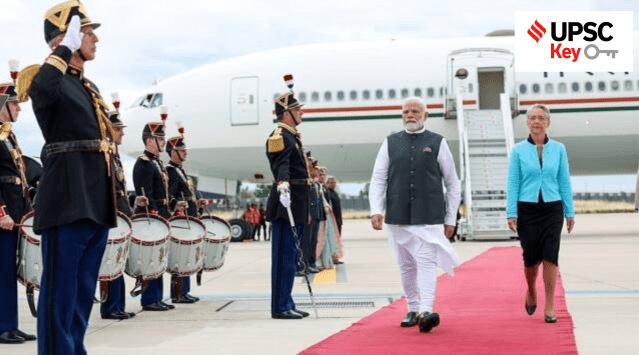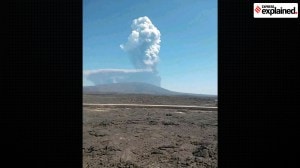
India-France ties strong, look forward to road map for next 25 years: PM
Syllabus:
Preliminary Examination: Current events of national and international importance.
Mains Examination: General Studies II: Bilateral, regional and global groupings and agreements involving India and/or affecting India’s interests.
Key Points to Ponder:
• What’s the ongoing story- Describing the bilateral relations between India and France as “strong, trusted and consistent”, Prime Minister Narendra Modi said on Thursday that the two countries are now at a “turning point” as they complete 25 years of strategic partnership, and looked forward to working on a roadmap for the next 25 years of the strategic partnership. Underlining that the India-France relationship is in “excellent shape”, Modi, who arrived in Paris on Thursday afternoon, said it “has been steady and resilient in the darkest storms”.
• In the backdrop of the 25th anniversary of the India–France strategic partnership, examine India-France bilateral relations
• PM Modi’s visit to France-why?
• PM Modi’s Visit to France-what are the key takeaways
• 25-year vision statement for India-France bilateral ties-What do you know about this?
Story continues below this ad
• In a key decision the Defence Acquisition Council (DAC) approved proposals to procure 26 Rafale Marine aircraft and three additional Scorpene submarines for the Indian Navy-Know more in detail
• For Your Information-The Rafale M aircraft will come with associated ancillary equipment, weapons, simulator, spares, documentation, crew training and logistic support. Their procurement from the French Government is on an Inter-Governmental Agreement (IGA) basis. Four of the 26 aircraft are likely to be the trainer version. With the MiG-29 Ks slated to be phased out in the next few years, procuring these aircraft is an interim arrangement for the Navy’s aircraft carriers, INS Vikramaditya and INS Vikrant, until it acquires the indigenous Twin Engine Deck-Based Fighter (TEDBF) which is currently under development by the Aeronautical Development Agency (ADA) under the DRDO.
• What is acceptance of necessity in Defence?
• For Your Information-The three additional Scorpene submarines will be procured under Buy (Indian) category and will be built by the Mazagon Dock Shipbuilders Limited (MDL). The MDL is building six Scorpene class submarines under Project-75 under transfer of technology from Naval Group which was a $3.75-billion deal signed in October 2005. Five of these have already been commissioned and the sixth will likely be commissioned early next year. The Ministry said the procurement of additional submarines, with higher indigenous content, will not only help in maintaining required force level and operational readiness of the Navy, but also create significant employment opportunities in the domestic sector. “It will also help the MDL in further enhancing its capability and expertise in submarine construction,” it said. The DAC also approved the proposal to lay down guidelines for achieving the desired indigenous content in all categories of capital acquisition cases. “It will help in achieving ‘Atmanirbharta’ in critical manufacturing technologies and life-cycle sustenance of defence platforms/equipment through indigenous manufacturing,” the Ministry said.
• India, besides being the “mother of democracy”, is a “model of diversity”-Comment
• Indian Diaspora in France-Know in detail
Story continues below this ad
• Prime Minister Manmohan Singh’s participation at the Bastille Day Parade in 2009 and Prime Minister Narendra Modi’s participation at the Bastille Day Parade in 2023-how things have changed since then between India and France?
• How is the India-France strategic partnership working towards climate change?
• India and France-Historical Background and Strategic partnership between the two Nations
• What is Bastille Day celebration?
• Do You Know-The national day of France is celebrated on July 14, also known as Bastille Day or Fête nationale française, and is marked by a long military parade, along with dancing and other merriment. Bastille Day can be said to have set in motion the decade-long French Revolution, which fundamentally altered French political and social life and influenced the foundational ideas of democracy across the world, popularising slogans such as “Liberté, Egalité, Fraternité” (Liberty, Equality, Fraternity). This was the day on which ordinary people stormed Bastille, a 14th century fortress-prison in Paris that was used to incarcerate political prisoners (the famous writer philosopher Voltaire and the infamous Marquis de Sade had both been kept at the Bastille at various times). Before the storming of the Bastille, both economic and social tensions had been building up in Paris for long. In the 1780s, the French economy was in dire straits, and King and Queen Louis XVI and Marie Antoinette were not helping matters with their image of irresponsible, profligate spenders. Crop failure and famine dealt further blows, and by 1788, even bread became unaffordable for a vast majority of people. Under pressure, Louis XVI summoned the Estates-General, a body that had been around for almost 400 years by then, but could be summoned, heard, or ignored at the King’s will. This body consisted of the clergy (First Estate), the nobility (Second Estate) and the commoners (Third Estate). When called by Louis XVI, the body was dominated by the commoners in numbers, but not in influence. After their calls for greater say for commoners were ignored, one faction broke away and established a new body, called the National Assembly. On June 20, 1789, this body took the Tennis Court Oath, that they would stay together till they wrote a new Constitution for France. Louis XVI, meanwhile, started moving more troops into Paris, adding to the uncertainty and tensions in the city. On July 11, he dismissed Jacques Necker, his popular and only non-high-born minister. Protests broke out, soon turning violent. Then on July 14, a huge, armed mob began marching towards Bastille. The reason the mob chose Bastille was because people imprisoned simply because the King said so, without trial and without publicly stated causes, were often housed here; although on July 14, 1789, the prison only had seven inmates, of no great consequence.
Story continues below this ad
• What are the main areas where the two countries cooperate?
• What are the challenges observed in the bilateral relations between India and France?
Other Important Articles Covering the same topic:
📍Connection deepens: Govt clears 26 Rafale jets, 3 Scorpene subs
📍UPI to work in France, longer student visa: PM
📍BASTILLE DAY, CLIMATE PLEDGE
📍The French Connection
📍PM Modi in France: What are the Bastille Day celebrations that he’ll attend
Yamuna hits record high, set to recede — slowly
Syllabus:
Preliminary Examination: Indian and World Geography
Mains Examination:
• General Studies I: Distribution of key natural resources across the world (including South Asia and the Indian sub-continent); factors responsible for the location of primary, secondary, and tertiary sector industries in various parts of the world (including India).
Story continues below this ad
• General Studies III: Conservation, environmental pollution and degradation, environmental impact assessment.
Key Points to Ponder:
• What’s the ongoing story- After touching 208.66 metres at 6 pm on Thursday, over a metre more than the previous record of 207.49 metres reported in 1978, the water level of the Yamuna is set to recede marginally by early Friday morning, after submerging the floodplains and leaving a few roads and low-lying areas of the national capital inundated. The water level remained constant at 208.66 metres at 7 pm as well. According to the Central Water Commission (CWC) forecast, marginal improvement is expected by 3 am on Friday with the levels expected to fall to 208.45 metres at the Old Railway Bridge. This would still be well above the river’s “danger” mark of 205.33 metres.
• What is floodplain and how it is formed?
• What are the benefits of floodplains?
• Where are floodplains most often found?
• What are the advantages and disadvantages of floodplains?
• What are the dangers of living on the flood plains?
• How illegal encroachment of Floodplains of Yamuna River affecting the entire ecology?
• Map Work-Yamuna (Source, Major cities, destination and Tributaries)
Story continues below this ad
• What were the National Green Tribunal on Yamuna Flood Plain in the past?
• What are the factors behind flooding in Delhi?
• For Your Information-A water regulator at Indraprastha Metro Station that collapsed and caused flood water to flow into the Ring Road, a barrage whose gates are stuck because of silt and a river that has not been dredged in decades — behind flooding in Delhi is a combination of factors that led water to enter areas that haven’t seen flooding in close to half a century.
According to Delhi Disaster Management Authority officials, a regulator at Indraprastha Metro Station, which had not been used or maintained for several years, collapsed because of its poor condition as well as the strong water pressure and inundated the Ring Road.
• Delhi woke up to a scene reminiscent of the Mughal era, when the Yamuna flowed alongside the Red Fort-Discuss
• Do You Know-“The Yamuna used to be where the Ring Road is. That’s why the Red Fort was built here… the Yamuna was to be a defence of the fort. The river began to move away, as rivers do, in the time of Muhammad Shah ‘Rangila’ (in the 18th Century). In 1911, when the decision to shift the capital to Delhi was taken, the territory was surveyed to identify the place where the capital will be located. The original location suggested was the Coronation Park area. But that year, 1911, in the monsoon, quite a lot of area in the Coronation Park and Kingsway Camp area was flooded. That’s why the decision was taken to locate the capital at Raisina Hill. In 1911, this area, parts of Civil Lines, Model Town, were flooded. This is part of the floodplain,” said writer Sohail Hashmi.
Story continues below this ad
• With the Yamuna rising to a 45-year record in Delhi and cities across North India facing flooding this week, what experts are saying?
• Why is the Yamuna flooding?
Other Important Articles Covering the same topic:
📍Why water entered key roads: Broken regulator, barrage clogged with silt
📍For a few hours, a river flowed along Red Fort
📍Yamuna rising: Experts call for better urban planning, governance
📍How incessant rains in North India led to rising Yamuna level
Story continues below this ad
Countdown on for Chandrayaan 3 launch today: soft landing on moon
Syllabus:
Preliminary Examination: Current events of national and international importance.
Mains Examination: General Studies III: Achievements of Indians in science & technology; indigenization of technology and developing new technology.
Key Points to Ponder:
• What’s the ongoing story- With the launch of Chandrayaan-3 today (July 14), the Indian Space Research Organisation (Isro) is set to make its second attempt to land a spacecraft on the moon. Earlier in 2019, due to problems that had emerged during the last stage of the descent, Chandrayaan-2’s lander and rover crashed on the moon’s surface.
Should this mission see a successful “soft” landing, India will become only the fourth country – after the United States, Russia, and China – to have done so.
• Firstly, how do space missions work?
• What are the Chandrayaan missions?
• What is Chandrayaan-3 mission?
• For Your Information-According to Isro officials, the Chandrayaan-3 will reach the lunar orbit almost a month after its launch, and its lander, Vikram, and rover, Pragyaan, are likely to land on the Moon on August 23. Notably, the landing site of the latest mission is more or less the same as the Chandrayaan-2: near the south pole of the moon at 70 degrees latitude. If everything goes well, the Chandrayaan-3 will become the world’s first mission to soft-land near the lunar south pole. All the previous spacecraft to have landed on the Moon have landed in the equatorial region, a few degrees latitude north or south of the lunar equator. The furthest that any spacecraft has gone from the equator was Surveyor 7, launched by NASA, which made a moon landing way back on January 10, 1968. This spacecraft landed near 40 degrees south latitude.
• Why hasn’t any spacecraft ever landed near the lunar south pole?
• Why do scientists want to explore the lunar south pole?
• Why don’t some parts of the lunar polar regions receive any sunlight?
• But why land near the south pole?
• Why will it take so many days for the lander to reach the moon?
• Why do we want to go to the moon?
• What is the name of Chandrayaan-3 lander Rover?
• Is Chandrayaan-1 success or failure?
• Has the Chandrayaan-2 mission encountered failure?
• What was the Chandrayaan-2 mission?
• What went wrong with the Chandrayaan-2’s Vikram lander?
• What was missed because of the crash landing?
• How Chandrayaan-3 mission is different from Chandrayaan-1 and Chandrayaan-2?
• Do You Know-The landing site for the integrated Vikram lander and Pragyan rover will remain the same as the previous mission: near the south pole of the moon at 70 degrees latitude. If successful, Chandrayaan-3 will become the first mission to soft land near the southern pole of the moon. The site was selected as it has several craters that remain permanently in shadows, increasing the chances of examining water ice. Chandrayaan 1, which also carried NASA payloads, was instrumental in confirming the presence of water and hydroxyl (OH) molecules on the moon. The mission will also make India the fourth country in the world to achieve soft landing on the moon after the US, Russia and China.
Other Important Articles Covering the same topic:
📍Chandrayaan-3 to be launched on July 12: Chandrayaan-2 and why it partially failed
THE IDEAS PAGE
Separate rights from freebies
Syllabus:
Preliminary Examination: Current events of national and international importance.
Mains Examination: General Studies II: Welfare schemes for vulnerable sections of the population by the Centre and States and the performance of these schemes
Key Points to Ponder:
• What’s the ongoing story-Aruna Roy and Nikhil Dey write: The current political discourse on freebies vs rights seems loud and superficial, like a shallow TV debate. A deeper examination of what constitutes a right and a freebie is needed in policy and political debates — nationally and globally. With large numbers of people living under conditions of extreme economic vulnerability in several countries, poverty alleviation should be the central focus for governments across the ideological spectrum. In electoral democracies, ensuring a minimum income is not only critical for the survival of millions, but it is equally critical to the survival of political parties. For electoral reasons — if nothing else — there is agreement across ideological divides that minimum income levels must be ensured. The question is, how should this be done?
• What is Minimum Income Guarantee Law?
• Know about Minimum Income Guarantee Law and its merits, its approach, provisions and implications?
• What is “Freebies”?
• Is there any definition of the term “freebies” given in the existing legal/policy framework?
• What is wrong with freebies?
• Promises made by the political parties, often driven by short-term electoral calculations, can be divided into two types-What are those two types of promises?
• The Supreme Court of India in its judgment dated July 5, 2013, accepted that the promises in manifestos cannot be construed as “corrupt practice” under the RP Act. However, it conceded that they do “influence the people and shake the roots of free and fair elections”-Know in detail about this verdict
• “India is a welfare state and the citizens are entitled to welfare schemes, but distributing things free can never be the only way of welfare”-Where to draw the line between welfarism and freebies?
• Oxfam’s 2022 annual report on inequality in India has many troubling, stark revelations-Know in detail
• For Your Information-According to Oxfam’s 2022 annual report on inequality in India, the number of poor doubled to 134 million as its dollar billionaires’ wealth doubled. The richest 1 per cent have amassed 51.5 per cent of the total wealth while the bottom 60 per cent of the population a mere 5 per cent.
• Critics have pointed out that provisions to poor beneficiaries are termed as “revdi” while state-sponsored support to the rich is called “incentive”-Compare and Contrast between “Revdi” and “Incentive”
• How freebies Impact Union and State budgets?
• Why the word ‘Freebie’ is almost sounds pejorative especially in political and policy circle?
• The political dialogue built around freebies is fraught with danger. What ‘danger’ is associated with Freebies scheme?
• How Budget is managed for Freebies schemes and Programmes?
Other Important Articles Covering the same topic:
📍As constitutional office, may not be apt to be part of SC panel on poll freebies: EC
📍Election monitor does well to refrain from stepping into debate on freebies. That discussion must remain in the political domain
📍From freebies to welfare
EXPLAINED
HOW RUSSIA HAS BECOME THE WORLD’s TOP WHEAT EXPORTER AT UKRAINE’S EXPENSE
Syllabus:
Preliminary Examination: Current events of national and international importance.
Mains Examination: General Studies II: Important International institutions, agencies and fora- their structure, mandate.
Key Points to Ponder:
• What’s the ongoing story- Russia is consolidating its position as the world’s top wheat exporter, even as Ukraine’s shipments are projected to more than halve from their peak and production plunge to a 11-year-low. The US Department of Agriculture (USDA) has estimated Russia’s wheat exports at a record 45.5 million tonnes (mt) in 2022-23 (July-June), up from 33 mt, 39.1 mt and 34.5 mt in the preceding three marketing years. In the process, it has left behind the European Union, which had exported 39.8 mt in 2019-20, before slipping to 29.7 mt, 32 mt and 34 mt in the following three years.
• Who is the biggest exporter of wheat?
• What is Black Sea grain Treaty?
• What’s the deal?
• Map Work-Black Sea
• Why grain deal is rebuked by Russia?
• What has been exported?
• How might the agreement change?
• Has it alleviated the food crisis?
• Has it driven down global wheat prices?
• For Your Information-The primary destinations for Russian wheat are the Middle East, North Africa and Central Asia, led by Egypt, Iran and Algeria. While the Black Sea Grain Initiative helped Ukraine export 16.8 mt in 2022-23, about 39% of its wheat actually moved via the land route to Eastern Europe, instead of the specially-created corridors for shipping from the three designated ports of Odesa, Chornomorsk and Yuzhny. Ukraine’s markets have shifted dramatically from Asia and North Africa before the war to mainly Europe, mostly due to ease of shipment, according to the USDA. Ample supplies from Russia have helped soften global wheat prices. Russian wheat is now being exported at around $235 per tonne, as against $275 three months ago, $310 six months ago and $375 a year ago. The relatively low international prices of wheat can be a comfort factor for countries like India; it might have to consider the option of wheat imports if the kharif rice crop does not turn out too good due to poor monsoon rain in major paddy-growing states.
Other Important Articles Covering the same topic:
📍Explained: What’s the significance of UN-backed grain export deal signed by Ukraine, Russia?
ECONOMY
India weighs better market access to join IPEF trade pillar
Syllabus:
Preliminary Examination: Current events of national and international importance.
Mains Examination: General Studies II: Bilateral, regional and global groupings and agreements involving India and/or affecting India’s interests.
Key Points to Ponder:
• What’s the ongoing story-India is learnt to have asked for better market access in order to be a part of the trade pillar of the Indo-Pacific Economic Framework for Prosperity (IPEF), a 14-nation trade bloc, officials said. Renewed deliberations within the Union Commerce Ministry are learnt to be centred on whether New Delhi should first take a commitment on joining even if there is lack of clarity about specific gains or join now instead as 13 countries are already negotiating the nitty gritties and if India were to accede later, it could be at a disadvantage at having missed out on the negotiations. As of now, market access has not been agreed upon for India, which is being seen as a crucial factor to join the trade pillar (Pillar-I), the official said. India has an observer status on the trade pillar negotiations.
• What is ‘Indo-Pacific Economic Framework (IPEF)’?
• Know the objectives of Indo-Pacific Economic Framework (IPEF)
• India’s Significance in Indo-Pacific Region-Brainstorm
• “The future of the 21st century economy is going to be largely written in the Indo-Pacific”-Decode the Quote
• What are the four pillars identified under the Indo-Pacific Economic Framework (IPEF)?
• Do You Know-The IPEF framework is structured around four pillars relating to Trade (Pillar I); Supply Chains (Pillar II); Clean Economy (Pillar III); and Fair Economy (Pillar IV). India has joined Pillars II to IV of IPEF while it had opted out from Pillar-I in September last year and now has an observer status in Pillar-I. “Under the IPEF trade pillar, they have not given market access yet. They are asking India to sign the trade pillar, but it is still not fully clear about what all we will get if we sign it. Earlier also India felt that we are not getting much out of it and environmental and labour laws conditions have been stringent. Some of the other countries are also finding these conditions as stringent and they are also negotiating it,” the official said. The 14-nation IPEF bloc is seen as crucial as it accounts for about 40 per cent of the world’s GDP and 28 per cent of the world’s trade in goods and services and is seen as an economic and trade strategy backed by the US to counter China’s economic influence in the region. India had been reluctant earlier to join Pillar-I in view of concerns to protect its domestic agricultural, labour and digital sectors without being completely sure about the impact of joining the IPEF.
• The Term ‘Indo-Pacific’-What does it mean? Define this term in Geopolitical and in geographical context.
• Know the importance of Indo-Pacific region for India
• India’s Indo-Pacific Strategy-Know in Detail
Other Important Articles Covering the same topic:
📍Explained: What is the Indo-Pacific Economic Framework?
For any queries and feedback, contact priya.shukla@indianexpress.com
The Indian Express UPSC Hub is now on Telegram. Click here to join our channel and stay updated with the latest Updates.


































